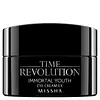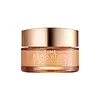What's inside
What's inside
 Key Ingredients
Key Ingredients

 Benefits
Benefits

 Concerns
Concerns

 Ingredients Side-by-side
Ingredients Side-by-side

Betula Alba Juice
AstringentCyclomethicone
EmollientDimethicone/Vinyl Dimethicone Crosspolymer
Skin ConditioningGlycerin
HumectantButylene Glycol
HumectantDipropylene Glycol
HumectantNiacinamide
SmoothingSilica
Abrasive1,2-Hexanediol
Skin ConditioningAcetyl Tetrapeptide-5
HumectantSh-Decapeptide-9
Skin ConditioningSodium Cocoyl Alaninate
Dimethicone
EmollientHydrogenated Lecithin
EmulsifyingCassia Alata Leaf Extract
AstringentAdenosine
Skin ConditioningHydrolyzed Myrtus Communis Leaf Extract
Skin ProtectingResveratrol
AntioxidantXanthophylls
Skin ConditioningAlgin
MaskingPolyglutamic Acid
Skin ConditioningTitanium Dioxide
Cosmetic ColorantPhenoxyethanol
PreservativeBetula Alba Juice, Cyclomethicone, Dimethicone/Vinyl Dimethicone Crosspolymer, Glycerin, Butylene Glycol, Dipropylene Glycol, Niacinamide, Silica, 1,2-Hexanediol, Acetyl Tetrapeptide-5, Sh-Decapeptide-9, Sodium Cocoyl Alaninate, Dimethicone, Hydrogenated Lecithin, Cassia Alata Leaf Extract, Adenosine, Hydrolyzed Myrtus Communis Leaf Extract, Resveratrol, Xanthophylls, Algin, Polyglutamic Acid, Titanium Dioxide, Phenoxyethanol
Water
Skin ConditioningGlycerin
HumectantCetearyl Alcohol
EmollientDipropylene Glycol
HumectantCaprylic/Capric Triglyceride
MaskingHydrogenated Poly(C6-14 Olefin)
EmollientNiacinamide
SmoothingPolyglyceryl-3 Distearate
EmulsifyingPentylene Glycol
Skin ConditioningMethyl Trimethicone
Skin ConditioningCaprylyl Methicone
Skin ConditioningPhenyl Trimethicone
Skin ConditioningGlyceryl Stearate Se
EmulsifyingButyrospermum Parkii Butter
Skin ConditioningHydrogenated Vegetable Oil
EmollientPolymethylsilsesquioxane
1,2-Hexanediol
Skin ConditioningDiisostearyl Malate
EmollientHelichrysum Italicum Flower Water
Skin ConditioningCetearyl Olivate
Sorbitan Olivate
EmulsifyingAmmonium Acryloyldimethyltaurate/Vp Copolymer
Chondrus Crispus Extract
Skin ConditioningCopernicia Cerifera Wax
Chlorella Vulgaris Extract
Skin ConditioningGlucose
HumectantButylene Glycol
HumectantSaccharum Officinarum Extract
MoisturisingAngelica Archangelica Callus Extract
Skin ProtectingParfum
MaskingEthylhexylglycerin
Skin ConditioningGlyceryl Stearate Citrate
EmollientFructooligosaccharides
HumectantFructose
HumectantGlyceryl Caprylate
EmollientPalmitic Acid
EmollientOctanediol
Stearic Acid
CleansingAdenosine
Skin ConditioningSodium Phytate
Melia Azadirachta Flower Extract
Skin ConditioningOcimum Sanctum Leaf Extract
Skin ConditioningEclipta Prostrata Extract
Skin ConditioningMelia Azadirachta Leaf Extract
Skin ConditioningDextrin
AbsorbentTheobroma Cacao Seed Extract
AntioxidantCurcuma Longa Root Extract
MaskingCorallina Officinalis Extract
Skin ConditioningAlthaea Rosea Flower Extract
Skin ConditioningHydroxystearic Acid
CleansingMaltodextrin
AbsorbentMoringa Oleifera Seed Oil
EmollientLimnanthes Alba Seed Oil
Skin ConditioningTocopherol
AntioxidantHydrogenated Lecithin
EmulsifyingPolyglyceryl-10 Oleate
Skin ConditioningPolyglyceryl-3 Methylglucose Distearate
EmulsifyingSwertia Chirata Extract
HumectantCholeth-24
EmulsifyingCeramide NP
Skin ConditioningWater, Glycerin, Cetearyl Alcohol, Dipropylene Glycol, Caprylic/Capric Triglyceride, Hydrogenated Poly(C6-14 Olefin), Niacinamide, Polyglyceryl-3 Distearate, Pentylene Glycol, Methyl Trimethicone, Caprylyl Methicone, Phenyl Trimethicone, Glyceryl Stearate Se, Butyrospermum Parkii Butter, Hydrogenated Vegetable Oil, Polymethylsilsesquioxane, 1,2-Hexanediol, Diisostearyl Malate, Helichrysum Italicum Flower Water, Cetearyl Olivate, Sorbitan Olivate, Ammonium Acryloyldimethyltaurate/Vp Copolymer, Chondrus Crispus Extract, Copernicia Cerifera Wax, Chlorella Vulgaris Extract, Glucose, Butylene Glycol, Saccharum Officinarum Extract, Angelica Archangelica Callus Extract, Parfum, Ethylhexylglycerin, Glyceryl Stearate Citrate, Fructooligosaccharides, Fructose, Glyceryl Caprylate, Palmitic Acid, Octanediol, Stearic Acid, Adenosine, Sodium Phytate, Melia Azadirachta Flower Extract, Ocimum Sanctum Leaf Extract, Eclipta Prostrata Extract, Melia Azadirachta Leaf Extract, Dextrin, Theobroma Cacao Seed Extract, Curcuma Longa Root Extract, Corallina Officinalis Extract, Althaea Rosea Flower Extract, Hydroxystearic Acid, Maltodextrin, Moringa Oleifera Seed Oil, Limnanthes Alba Seed Oil, Tocopherol, Hydrogenated Lecithin, Polyglyceryl-10 Oleate, Polyglyceryl-3 Methylglucose Distearate, Swertia Chirata Extract, Choleth-24, Ceramide NP
Ingredients Explained
These ingredients are found in both products.
Ingredients higher up in an ingredient list are typically present in a larger amount.
1,2-Hexanediol is a synthetic liquid and another multi-functional powerhouse.
It is a:
- Humectant, drawing moisture into the skin
- Emollient, helping to soften skin
- Solvent, dispersing and stabilizing formulas
- Preservative booster, enhancing the antimicrobial activity of other preservatives
Adenosine is in every living organism. It is one of four components in nucleic acids that helps store our DNA.
Adenosine has many benefits when used. These benefits include hydrating the skin, smoothing skin, and reducing wrinkles. Once applied, adenosine increases collagen production. It also helps with improving firmness and tissue repair.
Studies have found adenosine may also help with wound healing.
In skincare products, Adenosine is usually derived from yeast.
Learn more about AdenosineButylene Glycol (or BG) is used within cosmetic products for a few different reasons:
Overall, Butylene Glycol is a safe and well-rounded ingredient that works well with other ingredients.
Though this ingredient works well with most skin types, some people with sensitive skin may experience a reaction such as allergic rashes, closed comedones, or itchiness.
Learn more about Butylene GlycolDipropylene Glycol is a synthetically created humectant, stabilizer, and solvent.
This ingredient helps:
Dipropylene glycol is technically an alcohol, but it belongs to the glycol family (often considered part of the ‘good’ alcohols). This means it is hydrating and gentle on skin unlike drying solvent alcohols like denatured alcohol.
As a masking agent, Dipropylene Glycol can be used to cover the smell of other ingredients. However, it does not have a scent.
Studies show Dipropylene Glycol is considered safe to use in skincare.
Learn more about Dipropylene GlycolGlycerin is already naturally found in your skin. It helps moisturize and protect your skin.
A study from 2016 found glycerin to be more effective as a humectant than AHAs and hyaluronic acid.
As a humectant, it helps the skin stay hydrated by pulling moisture to your skin. The low molecular weight of glycerin allows it to pull moisture into the deeper layers of your skin.
Hydrated skin improves your skin barrier; Your skin barrier helps protect against irritants and bacteria.
Glycerin has also been found to have antimicrobial and antiviral properties. Due to these properties, glycerin is often used in wound and burn treatments.
In cosmetics, glycerin is usually derived from plants such as soybean or palm. However, it can also be sourced from animals, such as tallow or animal fat.
This ingredient is organic, colorless, odorless, and non-toxic.
Glycerin is the name for this ingredient in American English. British English uses Glycerol/Glycerine.
Learn more about GlycerinHydrogenated Lecithin is created from the hydrogenation of lecithin (a group of phospholipids). Hydrogenation is a chemical reaction between hydrogen and another element.
This ingredient is an emollient and emulsifier. As an emollient, it helps soften skin by trapping moisture within. As an emulsifier, it prevents oil and water ingredients from separating.
Niacinamide is a multitasking form of vitamin B3 that strengthens the skin barrier, reduces pores and dark spots, regulates oil, and improves signs of aging.
And the best part? It's gentle and well-tolerated by most skin types, including sensitive and reactive skin.
You might have heard of "niacin flush", or the reddening of skin that causes itchiness. Niacinamide has not been found to cause this.
In very rare cases, some individuals may not be able to tolerate niacinamide at all or experience an allergic reaction to it.
If you are experiencing flaking, irritation, and dryness with this ingredient, be sure to double check all your products as this ingredient can be found in all categories of skincare.
When incorporating niacinamide into your routine, look out for concentration amounts. Typically, 5% niacinamide provides benefits such as fading dark spots. However, if you have sensitive skin, it is better to begin with a smaller concentration.
When you apply niacinamide to your skin, your body converts it into nicotinamide adenine dinucleotide (NAD). NAD is an essential coenzyme that is already found in your cells as "fuel" and powers countless biological processes.
In your skin, NAD helps repair cell damage, produce new healthy cells, support collagen production, strengthen the skin barrier, and fight environmental stressors (like UV and pollution).
Our natural NAD levels start to decline with age, leading to slower skin repair, visible aging, and a weaker skin barrier. By providing your skin niacinamide, you're recharging your skin's NAD levels. This leads to stronger, healthier, and younger looking skin.
Another name for vitamin B3 is nicotinamide. This vitamin is water-soluble and our bodies don't store it. We obtain Vitamin B3 from either food or skincare. Meat, fish, wheat, yeast, and leafy greens contain vitamin B3.
The type of niacinamide used in skincare is synthetically created.
Learn more about Niacinamide